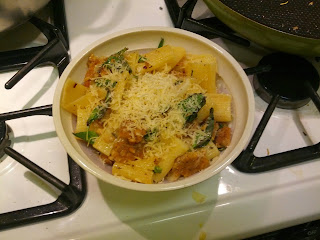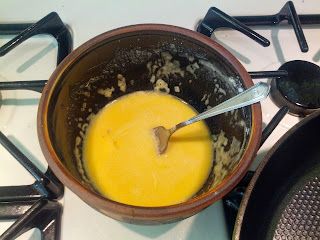Italian and Chinese chefs hate him! Make your own fresh noodles with this one weird trick!
A few weeks ago a took a class on handmade pasta. We made ravioli with goat cheese and edamame, ravioli with squash, and fettucini carbonara with shiitake mushrooms instead of bacon. What I took away from the class is that making pasta by hand is simpler than I had imagined.
This recipe was my first attempt since then to make some on my own, without adult supervision. In the class, we had pasta machines to roll the dough uniformly flat and slice it into noodle shapes (for the ravioli, we used stencils). I don't have a pasta machine at home, so this time I rolled it and cut it by hand.
Instead of sauce, I fried some vegetables and tomatoes, and then added the noodles to that. Sort of like the sauce I used to have with Lanzhou noodles (蘭州拉麵) in Chengdu.
NOODLES
1. Put two cups of flour in a mixing bowl. Make a well in the middle of the flour, and add two eggs.
Actually I forgot the proportions, so in the picture below I had only added one cup of flour -- hence the egg overflow. But the texture wasn't right until I added a full second cup.
Two eggs' worth is just about enough for one very hungry person. I'm sure you can adjust the amount according to how much you actually want to make.
2. Beat the eggs inside the well.
As you mix, the flour should start to get pulled into the egg mixture, making it thicker.
Keep mixing this way until most of the flour is absorbed, and it starts to look like dough, i.e. it's too thick to mix with a fork. Then switch to using your hands.
3. Knead the dough.
Use a floured surface, and press the dough until it has a uniform consistency, and isn't too dry or too sticky. Then knead some more.
Here's how you can tell if it's done: Form the dough into a ball. Make an indentation with your finger. If it returns to its original shape, you're good.
4. Wrap the dough in plastic or parchment, and let it sit for about half an hour.
Apparently, this lets the proteins and starches bind together better. You might be able to get away with a shorter wait time.
5. Roll the dough flat.
Also on a floured surface. I don't have a rolling pin, so I used a pint glass. A bottle would also work.
Try to make it as flat as you can, ideally in a rectangular shape.
6. Slice the noodles.
7. Bring water to a roiling burl. Add noodles. Burl for three minutes.
SAUCE
1. Slice four cloves of garlic, half a red bell pepper, two Roma tomatoes, a couple stalks of king oyster mushroom, and a few scallion sprigs.
2. Add olive oil to a heated pan. Add chili flakes, then the garlic, then the mushrooms. Cook for a minute on medium heat.
3. Add the tomatoes and peppers. Continue cooking for a few minutes.
4. Add a tablespoon or two of oyster sauce (I used a vegetarian, mushroom-based version), and a small splash of soy sauce.
6. Turn heat to low and wait until the noodles are done. Then add the scallions.
7. Now add the noodles. You can strain them first, or just pick them out of the pot with chopsticks or your hands. Just kidding about the hands.
8. Stir-fry for about 10 seconds, until the sauce and pasta are well combined. I fried them for about a minute, but I think this made the noodles too soft, since they had already been boiled long enough.
I actually used only half the noodles for this, so the other half I dipped in flour to keep from sticking, and put in a plastic container in the fridge. That was a couple days ago, and I haven't looked at them again since, so if there are any problems with this storage method I'll update this.


















